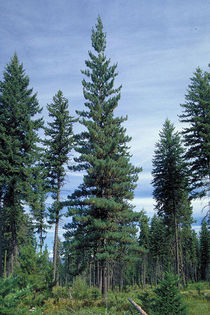
Picture of the has been licensed under a Creative Commons Attribution.
Original source: This image is Image Number 1171053 at Forestry Images, a source for forest health, natural resources and silviculture images operated by The Bugwood Network at the University of Georgia and the USDA Forest Service. Author Chris Schnepf, University of Idaho, USA
Author: Chris Schnepf, University of Idaho, USA
Original source: This image is Image Number 1171053 at Forestry Images, a source for forest health, natural resources and silviculture images operated by The Bugwood Network at the University of Georgia and the USDA Forest Service. Author Chris Schnepf, University of Idaho, USA
Author: Chris Schnepf, University of Idaho, USA

Picture of the has been licensed under a Creative Commons Attribution-Noncommercial-Share Alike license.
Permission: Some rights reserved
Permission: Some rights reserved
Western white pine
Western White Pine is a large tree, regularly growing to 30-50 m and exceptionally up to 70 m tall. It is a member of the white pine group, Pinus subgenus Strobus, and like all members of that group, the leaves are in fascicles of five, with a deciduous sheath. The needles are finely serrated, and 5-13 cm long. The cones are long and slender, 12-32 cm long and 3-4 cm broad , opening to 5-8 cm broad; the scales are thin and flexible. The seeds are small, 4-7 mm long, and have a long slender wing 15-22 mm long. It is related to the Eastern White Pine , differing from it in having larger cones, slightly longer-lasting leaves with more prominent stomatal bands, and a somewhat denser and narrower habit. The branches are borne in regular whorls, produced at the rate of one a year; this is pronounced in narrow, stand-grown trees, while open specimens may have a more rounded form with wide-reaching limbs. It is widely grown as an ornamental tree, but has been heavily logged throughout muWestern White Pine (Pinus monticola; family Pinaceae) is a species of pine that occurs in the mountains of the western United States and Canada, specifically the Sierra Nevada, the Cascade Range, the Coast Range, and the northern Rocky Mountains. The tree extends down to sea level in many areas, particularly in Oregon and Washington. It is the state tree of Idaho, and is sometimes known as the Idaho Pine. More
Flowering and Fruiting - Western white pine is monoecious. Three complete growing seasons are required for seed to mature. Strobilus buds are differentiated during July and August of the growing season before their appearance in June the following spring . More
